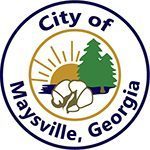History of Maysville 1847-1900
Early records indicate that Maysville was a small village in 1847, and was known as “Midway,” as it was midway between Lula and Harmony Grove (Commerce.) In 1869 a brick store was built, and the town’s residents began to refer to it as “Brick Store.” The name was later changed to Maysville, probably after John Mays, a prominent citizen who came to town with the railroad.
Maysville was incorporated on September 30, 1879. The town limits included parts of both Banks and Jackson Counties, and the original town limits were drawn to include ¾ of a mile in every direction from the Southern Railroad Depot. There were two significant fires in the town; in May, 1880, and the fall of 1897. Each time the town was rebuilt.
In 1878, regular meetings were being held by the Baptist, Methodist, and Presbyterian congregations. The Maysville Institute was established in 1879, and Maysville High School was established in 1891. Both schools were private and students paid tuition.
Regular passenger train service was in place twice daily between Lula and Athens. Traveling salesmen arriving on the train would hire buggies to reach Holly Springs, Dry Pond, and Homer. By the turn of the century, all of the streets were dirt, and there were more mules and horses than people.
This information was taken from the document “The Early History of Maysville, Georgia,” by Richard J. Chambers, presented to the Jackson County Historical Society in July, 1986.
History of Maysville from 1900
Maysville was a thriving town in the early 1900’s. Agriculture was the primary activity in the town and surrounding areas. There were 4 cotton gins, the largest of which was located on the property now occupied by the public library. There was a large cotton market, and each fall at least 18,000 bales were loaded on the trains for shipment. Farmers obtained goods and services from the local merchants, and “settled” their accounts when the crops were sold in the fall.
A public school system was established in 1907 when the town charter was amended to provide for the collection of property taxes. The largest churches were the Baptist, Methodist, and Presbyterian. Sunday services were held on different Sundays during the month, enabling residents to attend different churches. Two sections of town belonged to the black population, and these citizens maintained their own schools and churches.
Because the railroad tracks divided the city between Banks and Jackson Counties, an election was held in 1908, asking citizens whether they desired the city limits to remain in both counties, or change the lines to place the city within either Banks or Jackson Counties. Sixty-four residents voted for the town to be entirely within Banks County, and 57 voted for no change. Those opposed to the change petitioned a local judge to rule that the election procedures were irregular. The judge ruled the election invalid and the town remained split. This ruling was appealed to the State Supreme Court, which upheld the decision.
In 1919 there was a plant to process cottonseed oil, a fertilizer plant, and a seated chair factory. There were 4 physicians, 2 dentists, a 4 bed hospital, 2 practitioners of veterinary medicine, and 2 attorneys. There were 4 general stores carrying dry-goods as well as groceries, a millinery shop employing a special hat designer, shoe repair shop, garage, livery stable, and a bicycle repair shop. There was a telephone exchange with 2 telephones, one in the railroad depot and one in Tom Boone’s General Store. There was a weekly newspaper, 2 hotels, 2 boarding houses, and a funeral parlor.
During the early period, fuel for heating and cooking was either wood or anthracite coal.. There were pot-bellied stoves in the school classrooms which were tended by the students. Coal was delivered to town by the trains, and was unloaded near the depot where it was sold by weight.
Maysville thrived until the mid 1920’s when the stock market collapsed and the banks failed. The Great Depression had a devastating effect on the town, and the cotton market collapsed in the early 1950’s.
The first Autumn Leaf Festival was held in 1966, which was founded by the pastor of Maysville Baptist Church.
The most famous citizen of Maysville was the celebrated folk artist, Mattie Lou O’Kelly, She passed away in 1997.
Information for this section was provided by Sue Mealor and Smith Pounds. Historical photos were provided by the City of Maysville, Sue Mealor, Smith Pounds, and Gary Freeman.
